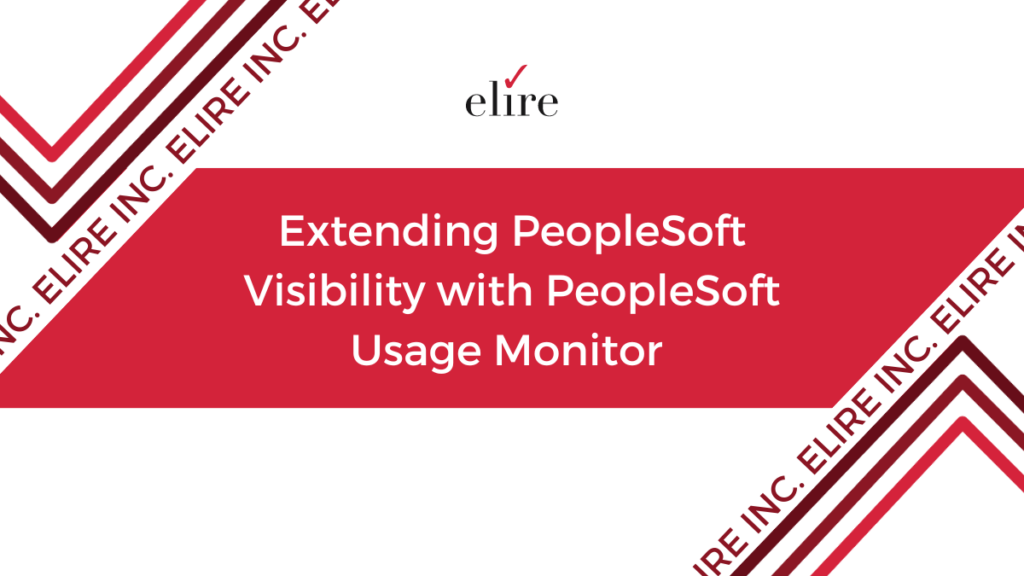
What is PeopleSoft Usage Monitor?
PeopleSoft Usage Monitor (UM) is a PeopleSoft-based utility that collects definitions accessed through PeopleSoft Internet Architecture (PIA) based on users and across a specified timespan. Definitions that can be collected include PeopleCode Events like FieldChange, FieldEdit, Records/Fields on SaveEdit, and other Managed Object references such as Components, Pages, and Fluid Page Composition details.
After data collection, these data points can be used in conjunction with the PeopleSoft Test Framework (PTF) to analyze test coverage functionality or standalone objects aggregated over a length of time. Visibility into what is being used during a testing lifecycle or live usage during production can give your IT support staff a glimpse never before available.
WHAT CHANGED ABOUT THE USAGE MONITOR IN PEOPLESOFT 8.60?
Before the new release of PeopleTools 8.60, PSFT production environments required a separate monitoring system to be set up to be able to leverage Usage Monitor. The independent monitoring environment required additional overhead and complex configuration before any UM data could be collected into the tables. Once the information had been collected on the Monitoring System, users completed programs to produce more tailored data points for better analysis by other PeopleSoft Tools.
The Performance Monitor Framework (PPM) required under 8.59 and prior created challenges for many end users due to its many moving dashboard components that needed setup and configuration.
Under PeopleSoft 8.60, Oracle Usage Monitor (UM) functionality has no dependence on the previous PPM but rather operates as its own entity. This automation tool works independently to collect UM data and monitor itself on all PeopleSoft systems.
WHAT ARE THE BENEFITS OF PEOPLESOFT USAGE MONITOR UNDER 8.60?
When used in tandem with Oracle PeopleSoft Test Framework, UM creates a test coverage report in real time, sending notifications to users on whether their test cases are covered for used objects or not. The Usage Monitor tool can also be used to analyze a Change Package’s impact by collecting data from different monitoring system databases and storing them in the PeopleSoft Update Manager (PUM) UM table. The UM table with Elire’s tools and indexes in OpenSearch Dashboards can analyze what lifecycle elements are used during testing phases and if customizations are leveraged in production.
A combination of our processes in conjunction with Elire’s scope object tracker can guide an upgrade optimization or PUM update with unprecedented accuracy. Ultimately, Oracle UM enhancements allow for a better user experience, guiding administrators to more precisely understand what definitions in the database are being used in their system. This can then assist with impact analysis, which is especially crucial when applying updates or changing packages.
WHAT’S NEXT?
For more information on Oracle’s PeopleSoft Usage Monitor tool, check out the “PeopleSoft Usage Monitor – Made Easy to Use” blog post on Oracle’s website.
To learn more about how new PeopleSoft upgrades, Oracle Cloud Service HCM, PeopleSoft applications, or how these new features and benefits can evolve your business processes, subscribe to Elire’s PeopleSoft Newsletter and stay updated on all things PeopleSoft 8.60.
In the meantime, follow us on LinkedIn and Twitter to receive real-time PeopleSoft updates and industry insights. If you have any questions, please reach out to [email protected] directly.
Authors
-

Valentin Todorow has 16 years of PeopleSoft and Cloud Technical and Functional experience. He has built various solutions with Cloud and PeopleSoft Test Management tools, and serves as a Subject Matter Expert to clients and the PeopleSoft and Cloud community.
View all posts -

Ms. Hutchcraft serves as Elire’s Marketing Specialist, working to develop and optimize marketing brand assets. Jordan collaborates with the Elire Team to produce blog and social media content, strategize for social media expansion, and maintain Elire’s internal and external branding.
View all posts
